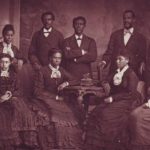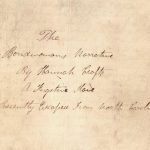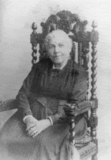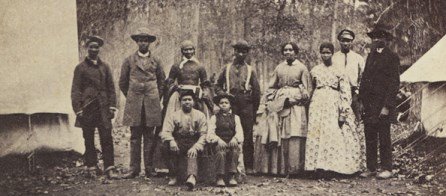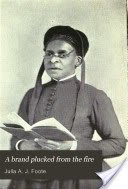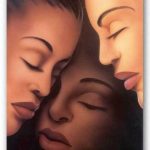African American Folk Artist in the South
Harriet Powers is one of the best African American quilt makers in the South in the Civil War era. Although only two of her older quilts have survived, she is now nationally recognized. Using the applique technique, Powers told stories with her quilts, depicting scenes from the Bible and events in American history.
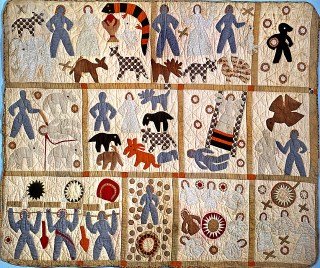
Harriet Powers’ Bible Quilt (1886)
Eleven scenes from Bible stories
Patchwork and applique
Early Years
Harriet Powers was born a slave on October 29, 1837 near Athens, Georgia, and was raised as a slave. For most of her life she lived in Clarke County, primarily in Sandy Creek and Buck Branch. Harriet was initially believed to be illiterate, but a letter written by her decades later tells us that she learned to read with the help of her white master’s children.
She married Armstead Powers, and they had at least nine children; their first daughter Amanda was born in 1855 when Harriet was 18. The Civil War freed the slaves but also brought great hardship to both the white and black populations in Clarke County, Georgia. Widespread poverty after the war deeply affected the Powers family.
Harriet’s Quilts
Powers probably made many other quilts in her lifetime, but only two of her story quilts have survived: the Bible Quilt (1886) and the Pictorial Quilt (1898); they are sometimes called narrative quilts. They are among the most famous works of art in the history of African American folk art, and are considered the most well preserved examples of 19th century Southern quilting in existence. Textile historians have noticed great similarities between Powers’ applique work and the technique mastered by the Fon people of Dahomey, West Africa.
Southern women slaves were often trained as expert seamstresses, and Harriet Powers more than likely learned the art of applique quilt making from her mother or other slaves. Women slaves often did fancy needlework for their owners during the daylight hours and made clothing and bed covers for their own families by candlelight. Quilt making has always been an art form linked not only to Americans, but also to African Americans.
Patchwork and applique are the techniques used primarily in African American quilts. Patchwork consists of sewing together cloth that has been cut into strips, strings, rectangles, triangles or squares. African women brought with them a knowledge of strip weaving, applique techniques and storytelling, which they adapted to their lives in the southern United States.
Applique is a technique in which figures or shapes are cut out of cloth are sewn onto a larger piece of background fabric, which is called a block. The background is usually a solid color and may be the same or different for each block, while the figures and shapes are most often cut from printed fabrics. Each block creates a different scene or design.
The individual blocks / scenes are then sewn together to create the patchwork quilt top, which is then assembled into a quilt sandwich: the quilt top + batting material (the stuffing) + a backing fabric that is the same size as the quilt top. These three layers are then quilted together, either by hand or by machine, using tiny, even stitches in lines or patterns throughout the quilt.
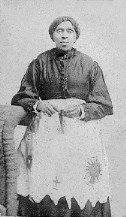 Image: Harriet Powers
Image: Harriet Powers
The Bible Quilt
Powers’ Bible Quilt (1886) depicts scenes from Bible stories, and is made of 299 separate pieces of fabric stitched to a background of watermelon pink fabric, which is now extremely faded. It is both hand- and machine-stitched, with outline quilting around the motifs and in random intersecting straight lines in the open spaces. A one-inch border of printed cotton is folded over the edges and machine-stitched through all layers.
Powers first exhibited her Bible Quilt at the Athens Cotton Fair of 1886, where it captured the attention of Onetta Virginia (Jennie) Smith, a local white artist who was then head of the art department at the Lucy Cobb Institute, a girls’ school in Athens. Jennie Smith wrote:
I have spent my whole life in the South, and am perfectly familiar with thirty patterns of quilts, but I had never seen an original design, and never a living creature portrayed in patchwork, until the year 1886, when there was held in Athens, Georgia, a Cotton Fair, which was on a much larger scale than an ordinary county fair, as there was a ‘Wild West’ show, and Cotton Weddings; and a circus, all at the same time.
There was a large accumulation of farm products… and in one corner there hung a quilt – which captured my eye and after much difficulty I found the owner, a Negro woman, who lives in the country on a little farm whereon she and husband make a respectable living. She is about sixty five years old, of a clear ginger cake color, and is a very clean and interesting woman who loves to talk of her old mistress and life before the war…
Her style is bold and rather on the impressionists order while there is a naievete of expression that is delicious… The scenes on the quilt were biblical and I was fascinated. I offered to buy it, but it was not for sale at any price.
However, the two women kept in touch. Four years later, at the urging of her husband, Powers offered to sell the quilt, but Ms. Smith’s “financial affairs were at a low ebb and I could not purchase.”
Ms. Smith wrote:
[The following] year I sent her word that I would buy it if she still wanted to dispose of it. She arrived one afternoon in front of my door in an ox-cart with the precious burden in her lap encased in a clean flour sack, which was still enveloped in a crocus sack [burlap bag]. She offered it for ten dollars, but I told her I only had five to give. After going out to consult with her husband she returned and said “Owing to the hardness of the times, my old man allows I’d better take it.”
Not being a new woman [an educated and independent woman] she obeyed. After giving me a full description of each scene with great earnestness, she departed but has been back several times to visit the darling offspring of her brain. She was only in measure consoled for its loss when I promised to save her all my scraps.
Powers explained the imagery of each of the eleven blocks on the quilt; Ms. Smith recorded these descriptions in her personal diary. Since the watermelon pink background fabric has faded, it is difficult to discern the figures that were cut from lighter colored fabrics. The individual panels, starting in the upper left:
FIRST ROW:
1. Adam and Eve in the garden of Paradise, at the moment when the serpent is about to tempt Eve. 2: Eve has given birth to a son.
3. Satan amidst the seven stars.
SECOND ROW:
4. Cain kills his brother Abel, and blood pours from his neck.
5. Cain going into the land of Nod to get a wife.
6. Jacob dreams about the angel on a ladder.
7. The baptism of Christ; the Holy Spirit is present in the brown bird-like object.
THIRD ROW:
8. The crucifixion, with the sun and moon turning into blood.
9. Judas Iscariot and the thirty pieces of silver.
The large star at the bottom refers to a star that was seen in 1886 for the first time in 300 years.
10. The Last Supper, as seen from above. Judas is dressed differently from the others who are all in white.
11. The Holy Family and the Star of Bethlehem.
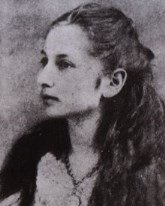 Image: Jennie Smith
Image: Jennie Smith
Jennie Smith entered Harriet Powers’ Bible Quilt at the 1895 Cotton States and International Exposition in Atlanta, Georgia. The quilt is now part of the African American Folk Art collection of the Smithsonian Institution in Washington, DC.
By the 1880s, the Powers family owned four acres of land. In the 1890s, they fell on hard times and were forced to sell off part of their land but not their home. Sometime around 1894, Armstead Powers abandoned Harriet and their farm; she never remarried, but remained independent in her home at Sandy Creek, probably supporting herself as a seamstress.
The Pictorial Quilt
In 1898 the wives of faculty members at Atlanta University, who had seen the Bible Quilt at the Cotton States Exhibition in Atlanta in 1895, commissioned a story quilt from Harriet Powers. This quilt was presented as a gift to the Rev. Dr. Charles Cuthbert Hall, a white minister who was the longtime chairman of the board of trustees of Atlanta University and who championed higher education for African Americans.
Crafted of patchwork and the African applique technique, along with European and biblical influences, the fifteen rectangular blocks of the Pictorial Quilt illustrate Bible stories, legends, natural disasters and events in American history. This is Powers’ description of all fifteen blocks starting in the upper left:
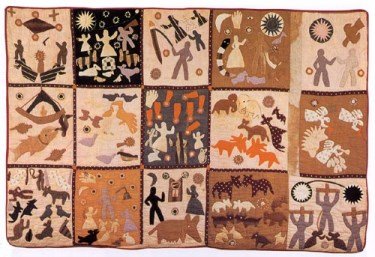 Image: Harriet Powers’ Pictorial Quilt
Image: Harriet Powers’ Pictorial Quilt
Fifteen blocks depicting scenes from the Bible, nature and American history
Cotton fabric, metallic yarns, 69″ x 105″
FIRST ROW:
1. Job praying for his enemies; Job’s crosses; Job’s coffin.
2. The Dark Day of 1780:
An unusual darkening of the day sky was observed over the New England states and parts of Canada on May 19, 1780. The sun diminished to a small spot and then to darkness, which was so complete that candles were required from noon on. The citizens were terrified. The stars could be seen at 12 noon; the cattle went to bed and the chickens to roost. The sun returned the following day. The primary cause of the event was a combination of smoke from Canadian forest fires, thick fog and heavy cloud cover.
3. The serpent lifted up by Moses; women bringing their children to look upon it to be healed.
4. Adam and Eve in the garden; Eve tempted by the serpent; Adam’s rib by which Eve was made; the sun and the moon; God’s all-seeing eye; God’s merciful hand.
5. John baptizing Christ and the spirit of God descending and resting upon his shoulder like a dove.
SECOND ROW:
6. Jonah was cast overboard and swallowed by a whale; turtles.
7. God created two of every kind, male and female.
8. The Night of Falling Stars:
On November 13, 1833 the sky was so bright with shooting stars that a newspaper could be read on the street. One writer says, “For nearly four hours the sky was literally ablaze.” The people were frightened and thought that Judgment Day had come, but the phenomenon was later identified as the famous Leonid meteor shower of 1833.
9. Two of every kind of animal continued… camels, elephants, giraffes, lions…
10. The angels of wrath and the seven vials; the blood of fornications; the seven-headed beast and 10 horns which arose out of the water.
THIRD ROW:
11. Cold Thursday:
This block refers to the unusually heavy snowfall and sub-zero temperatures on February 10, 1895 in Athens, Georgia, a most unusual occurence. A woman frozen while at prayer; a woman frozen at a gateway; a man with a sack of meal frozen; icicles formed from the breath of a mule, all blue birds killed; a man frozen at his jug of liquor.
12. The red light night of 1846:
A man tolling the bell to notify the people of the wonder; women, children and fowls frightened by God’s merciful hand caused no harm to them.
13. Rich people who were taught nothing of God: Bob Johnson and Kate Bell of Virginia. They told their parents to stop the clock at one and tomorrow it would strike one and so it did. Sent to hell at the tolling of the clock and damned for eternity. The hog named Betts ran 500 miles from Georgia to Virginia.
14. The creation of animals continues.
15. The crucifixion of Christ between the two theives. The sun went into darkness. Mary and Martha weeping at his feet. The blood and water run from his right side.
The quilt remained in the Hall family for several decades. The reverend’s heirs then sold the quilt to folk art collector Maxim Karolik, who then donated the quilt to the Museum of Fine Arts in Boston, Massachusetts. It was the centerpiece of a major exhibition of American Folk Art there in the summer of 2001.
Harriet Powers died January 1, 1910 at the age of 72, and was buried in the Gospel Pilgrim Cemetery in Athens, Georgia. Her grave was rediscovered in January 2005.
Honors
In 2009, Powers was inducted into the Georgia Women of Achievement Hall of Fame. In October 2010, there were a series of events in Athens, Georgia, around the theme Hands That Can Do: A Centennial Celebration of Harriet Powers. The events included a quilt exhibit, storytelling, a gospel concert, a symposium, a commemorative church service and a visit to the Powers grave site. Athens Mayor Heidi Davison issued a proclamation naming October 30, 2010, as Harriet Powers Day.
Excerpt from Encyclopedia of Southern Culture (1989):
Afro-American [sic] quilt making is inextricably linked to the thrift and industry that characterize rural black southern life, for Afro-American quilters grew up in a time when there was no social security and to survive was to keep constantly busy. Afro-American quilt making is unique in America, fusing two alternative textile traditions – the African and the Euro-American to produce a third. Afro-American quilters maintaining this hybrid aesthetic demonstrate the strength of African cultural traditions in contemporary American society, affirming the extraordinary tenacity of African ideas over hundreds of years in the face of major historical obstacles.
SOURCES
Wikipedia: Harriet Powers
Gospel Pilgrim Cemetery: Harriet Powers
African American Registry Harriet Powers An Artist of Story Quilts
National Museum of American History: Harriet Powers’s Bible Quilt

